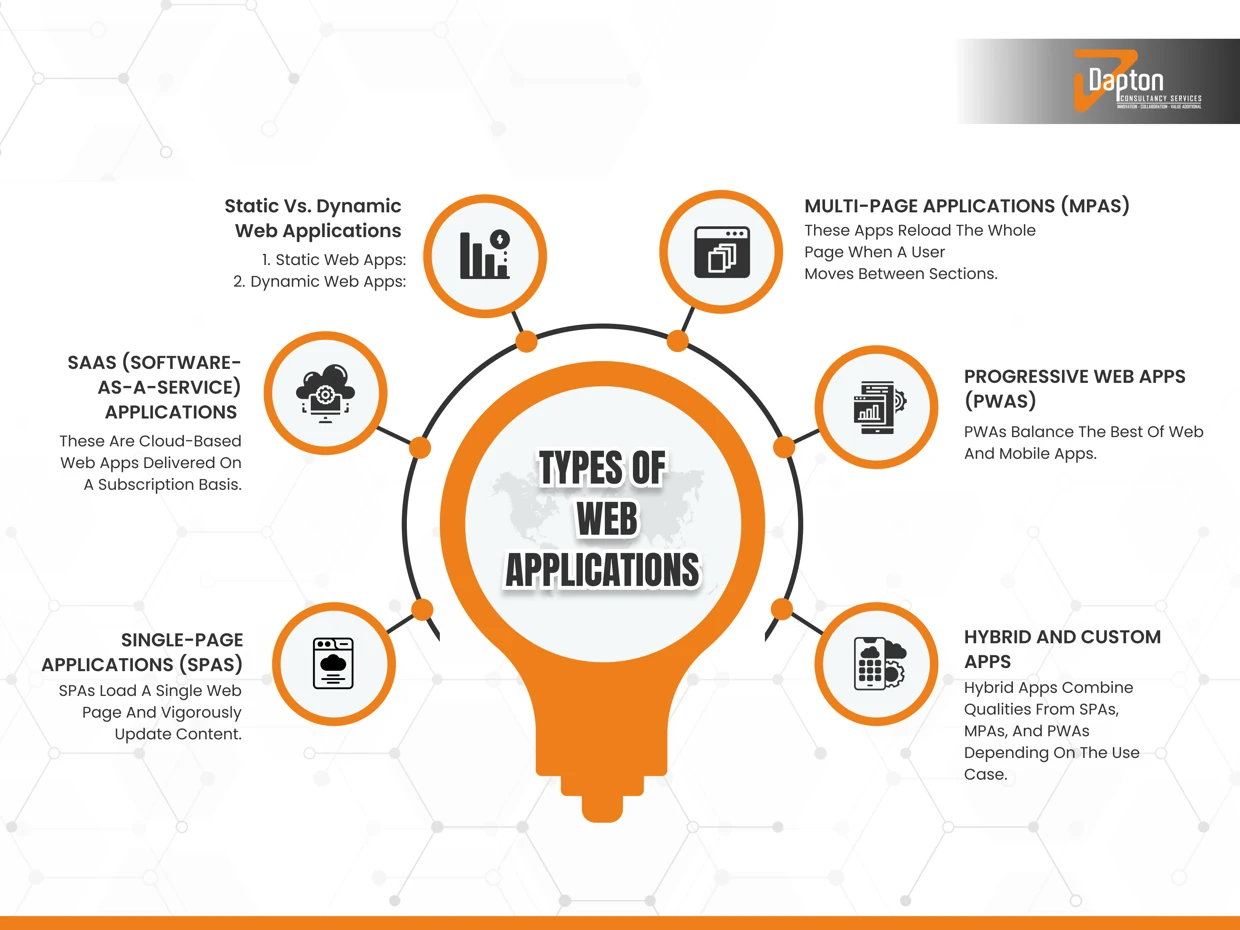Web application development is the process of creating interactive web apps. These apps run in your web browser – like online shopping platforms, booking tools, or dashboards.
In this guide, we will walk you through the basics of custom web application development. Most importantly, we will highlight why partnering with a web application development company can make or break your project.
Types of Web Applications

We explored what is web application development. Let us explore in detail the diverse types of web applications offered by a web application development company.
Static vs. Dynamic Web Applications
Static Web Apps:
- They are basic and fast-loading applications that display the same content for every user. Static apps are ideal for simple sites like work portfolios or landing pages.
Dynamic Web Apps:
- They are interactive applications where content changes based on user inputs. Dynamic apps are ideal for smart dashboards and online booking portals.
SaaS (Software-as-a-Service) Applications
These are cloud-based web apps delivered on a subscription basis. Users access them via – browsers, and no installation is needed. Examples include Salesforce, Slack, and Google Workspace. SaaS apps are ideal for businesses seeking scalable and pay-as-you-go solutions.
Single-page Applications (SPAs)
SPAs load a single web page and vigorously update content. They work without reloading the entire page. SPAs offer a smooth, app-like experience in your browser. Popular SPAs include – Gmail, Trello, and Google Maps.
Multi-page Applications (MPAs)
These apps reload the whole page when a user moves between sections. While heavier than SPAs, they are suited for large-scale platforms. They are well-suited to eCommerce sites that need robust SEO and content depth.
Progressive Web Apps (PWAs)
PWAs balance the best of web and mobile apps. They work offline, load fast, and can be installed on your home screen. They work like a native app but are entirely web-based. These apps improve mobile experiences without the cost of native app development.
Hybrid and Custom Apps
Hybrid Apps combine qualities from SPAs, MPAs, and PWAs depending on the use case. Custom Apps are built from the ground up for your unique business needs. They are ideal for specific workflows and deep integrations.
The Web Application Development Process
Turning ideas into a web application involves several stages for a web application development company. Let us explore how to build a web application –
Planning and Requirement Gathering
The development team meet with client stakeholders to comprehend business needs. They understand user expectations, business objectives and technical goals. This phase sets the roadmap – defining core features, timelines, and success metrics.
UX/UI Design
Designers craft wireframes and mock-ups. They visualize how the app will – look and feel. The objective is to – ensure intuitive navigation and seamless interactions. The UX/UI team creates a visually appealing interface that meets user expectations.
Frontend and Backend Development
Let us individually explore frontend vs backend development.
Frontend Development:
It brings the visual design to life. Front-end developers use technologies like – HTML, CSS, JavaScript, and frameworks like React or Angular.
Backend Development:
It powers the logic and database interactions. Backend developers handle everything – behind the scenes with tools like – Node.js, Python, or PHP.
Testing and Quality Assurance
An app goes through multiple tests – functional, usability, performance, and security. Testing and QA teams ensure – that everything works as intended across devices. Bugs are fixed, features are fine-tuned, and user experience is polished by the teams.
Deployment and Maintenance
Successful deployment and ongoing maintenance ensure smooth app performance. However, a trusted web application development company further facilitates scalability as your business needs evolve with time.
Significant Aspects of Web Application Architecture
A web application development company designs an architecture of how a web app will work together. It is the structural design that ensures your app is swift, secure, and scalable.
Client-Server Model
It is the foundation of web apps:
- Client: What the user views and engages with (web browser or mobile view).
- Server: Where the data lives and logic happens in the backend.
MVC (Model – View – Controller)
MVC is a pattern for well-organizing code. It separates:
- Model = data
- View = what users see
- Controller = manages logic and input
This scenario makes web apps easier to manage and scale.
MVVM (Model–View–ViewModel)
MVVM is a software architectural pattern that unlocks several strategic advantages in custom web application development. It enables clean code, modularity, and a scalable UI experience.
Microservices Architecture
A web application development company uses microservices to break an app’s functionalities into independent modules. It is easier to upgrade, test, and scale applications through microservices.
API-First Approach
Modern apps are built with APIs at the core. They let different services “talk” to each other. This is a great approach by a web application development company for integrating the app with CRMs, ERPs, and payment gateways.
Cloud-Native Approach
Cloud-native apps are built specifically to run on cloud platforms like AWS, Azure, or Google Cloud. They auto-scale, update smoothly, and are easier to sustain than conventional on-premise systems.
How Businesses Use Web Applications
A custom web application development company build apps to help businesses improve efficiency, customer experience, and operational control. According to Statista, revenue of Custom Web App Market would increase by 5.01% every year between 2024 and 2029, reaching out US $898.90 billion by the year 2029. Let us further explore how businesses use web applications globally.
eCommerce
From shopping carts to customer dashboards, web apps power online stores and marketplaces. They handle everything from product browsing to payment processing and inventory management.
Examples: Shopify stores, custom-built marketplaces, B2B ordering portals, Magento, WooCommerce, BigCommerce
CRM (Customer Relationship Management)
Web-based CRMs help businesses track leads, manage customer interactions, and automate marketing workflows—accessible from any device.
Examples: Zoho CRM, HubSpot, Salesforce (SaaS platforms), Suite CRM, Vtiger CRM
ERP (Enterprise Resource Planning)
ERP web apps bring together core business operations like accounting, procurement, inventory, and HR—centralizing them on a single cloud-based interface.
Examples: Odoo ERP, SAP Business One, ERPNext and Custom ERP Dashboards
Benefits of Custom Web Applications
A web application development company shapes custom web apps specifically around your business goals. Let us explore why businesses choose tailored solutions over off-the-shelf platforms –
Tailored User Experience & Workflows
A trusted web application development company designs custom apps around how your customers work. This means enhanced productivity and an intuitive experience that reflects your highly precise workflows.
Better Integration with Existing Systems
Whether it is your ERP, CRM, payment gateways, or third-party APIs, custom apps are – engineered to fit seamlessly into your tech ecosystem. This avoids data duplication and enables smoother operations.
Enhanced Data Control and Security
With a custom solution, you can control how and where your data is – stored, accessed, and secured. That translates to – fewer vulnerabilities, more compliance flexibility, and better protection against threats.
Competitive Advantage and Scalability
Custom apps evolve with your business – allowing you to add features, scale performance, and innovate faster than competitors.
Web Application Use Cases
A web application development company can revolutionise the approaches businesses can deliver their services.
E-Commerce Use Cases: Powering Digital Retail
In eCommerce, web applications enable – seamless shopping experiences, real-time inventory updates, and safeguard transactions.
Key Use Cases:
- Product Listing & Search: Dynamic product listings with filters, recommendations, and real-time accessibility.
- Shopping Cart & Checkout: Persistent carts, discount engines, and multi-step checkout flow.
- Order Management: Track orders, returns, and delivery status through blended dashboards.
- Customer Portals: Personalised accounts with order history, wish lists, and loyalty programs.
- Admin Dashboards: Manage inventory, pricing, promotions, and analytics in real-time.
Healthcare Use Cases: Empowering Digital Care Delivery
In healthcare, web apps are transforming – patient care, data management, and service provider workflows.
Key Use Cases:
- Telemedicine Portals: Better enable – video consultations, appointment scheduling, and e-prescriptions.
- Electronic Health Records: Centralised access to patient history, laboratory results, and treatment plans.
- Patient Portals: Allow patients to view records, book appointments, and connect with doctors.
- Hospital Management Systems: Streamline billing, insurance claims, and resource allocation.
- Remote Monitoring: Track vitals and chronic conditions through connected devices and real-time dashboards.
Understanding the Cost of Web Application Development
A reliable web application development company builds cost-efficient yet effective apps to empower businesses. Custom software typically breaks even in 2 to 3 years and continues to deliver ROI through – reduced licensing, automation, and improved productivity.
Off-the-shelf tools offer faster deployment and lower upfront costs but often accumulate hidden expenses, such as integration, training, and feature limitations, that negatively impact ROI over time.
In 2024, the web application development market was valued at USD 70.6 billion. By 2033, the overall market size will double and reach a USD 141.49 billion valuation.
Key Factors That Influence Web Application Development Cost
Let us explore some significant aspects that impact web application development costs.
- Project Scope: The number of features, complexity of workflows, and integration needs.
- Functionality & Features: User roles, dashboards, third-party APIs, and payment systems.
- Technology Stack: Some stacks are more cost-effective than others, based on developer accessibility and maintenance.
- Development Team: Local agencies or offshore teams all bring different pricing tiers and skill levels.
- Timeline and Speed: Tighter timelines require more resources, which will increase costs.
Moving Forward!
Web application development services have become a cornerstone for modern businesses. They enable scalable solutions, seamless customer experiences, and smarter internal workflows.
So, partnering with a professional web application development company – is a highly strategic investment.
Partner with Dapton Consultancy Services to enable scalability and remove performance bottlenecks through our custom web application development services.



